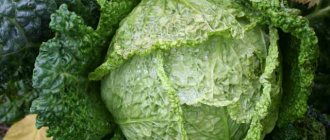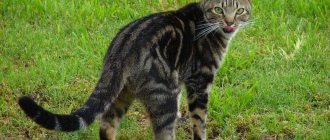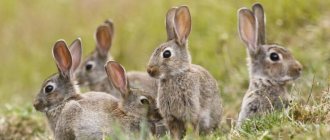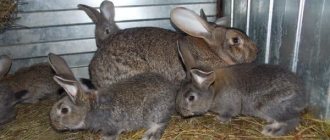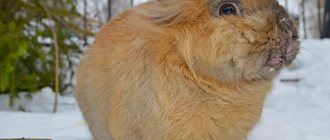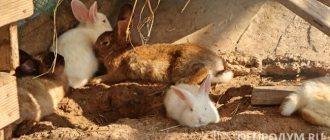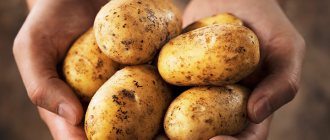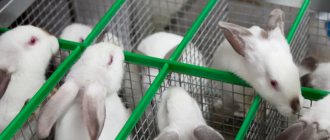The New Zealand White (NZW) rabbit breed was developed in 1910 in the United States of America and today it is one of the most popular breeds in Europe and the USA. The main goal of the breeding professors was to obtain a breed of pure, uniform white color with high meat performance. To do this, they used Albino animals of the New Zealand Red breed and White Giants (otherwise the Flanders breed). Having arrived in Russia only in 1971, the New Zealand White rabbit breed has taken root well in the harsh climate of our country and is quite common to this day.
About the breed
The main characteristics of the New Zealand White breed are:
- meat orientation;
- high ability to reproduce;
- calm disposition;
- unpretentiousness in content.
Purebred rabbits of this breed are not large, live weight is about 4-5 kg. The body of the animal is cylindrical, muscular and without excess fat deposits. The length of the male is 47 cm, the female is 49 cm. They have a short neck, a low-set head with thick short (10 cm) ears, red eyes, wide shoulder blades, a fleshy back and a well-developed hindquarters (about 224-25 cm wide). cm). Females may have a symmetrical and not very large dewlap, but this is not acceptable for males. The New Zealand White rabbit should also have a perfect bite, snowy white hair with a silver undercoat and white claws.
Productivity
The main value when breeding White Giant rabbits is high-quality snow-white fur, which does not have any extraneous color inclusions. The fur of animals is extremely silky, thick and pleasant to the touch.
The meat characteristics of the giant are considered no less valuable. Given proper maintenance and a carefully balanced diet, rabbits show very rapid growth rates - by the age of 2 months their weight reaches 1350-1650 g.
At 4 months, the body weight of the animals reaches 2550-2850 g. It is this period that is accompanied by the most active weight gain. An adult Albino rabbit weighs up to 490-5400 g, occasionally larger individuals weighing up to 7000-7900 g are found. Males are 600-800 g heavier than females.
Breeding and maintenance.
Breeding New Zealand white rabbits is economical both financially and in time, and therefore, with the right approach, is a profitable business! The breed is early maturing and therefore very prone to obesity, which is unacceptable. In connection with this circumstance, it is recommended to cover females from 4.5 to 5 months. A female rabbit that has entered the active breeding season must be fertilized between the 10th and 20th day after giving birth, otherwise the animal will begin to rapidly gain fat. Before starting the processes associated with reproduction, rabbits should be prepared by making the required vaccinations in advance and increasing immunity, because a weak animal will give weak offspring!
Females of the New Zealand White breed in one litter produce 8-12 rabbits weighing 45 grams.
Being excellent mothers, they feed at least 8 cubs well until they are born. A female rabbit produces a lot of milk, it is fatty and therefore the young animals grow quickly and gain weight on it. The average daily gain at the age from 0 to 21 days is 15 g, from 21 to 56 days - 41 g, at the age from 56 to 98 days - 33.2 g. At two months of age the weight is 1.8 - 2.2 kg, at 3 months 3-3.3 kg, the animal can be slaughtered. The slaughter yield is 54% - 58%, the meat yield is 77.5%, the skin is a secondary product. The basic rule for breeding New Zealand white rabbits is proper placement and care. Unlike their fellow New Zealanders of the red breed, white New Zealanders are more hardy, calm, have better health than other breeds and are resistant to harsh sounds, which allows them to be bred next to other animals.
It is better to keep rabbits indoors with an optimal temperature of 15 - 17 degrees. When kept outdoors, some productive qualities are lost. Rabbits do not tolerate heat well, and 25 degrees is considered critical; the animal can get heatstroke. In addition, cages with rabbits should not be in direct sunlight; also, due to high temperatures, males become practically sterile, which adversely affects reproduction. The cages should be spacious with a nesting compartment. One of the advantages of keeping rabbits of this breed is their adaptability to living on mesh floors due to their well-furred paws, which reduce the risk of diseases such as pododermatitis of traumatic origin. When properly maintained, rabbits are least susceptible to various diseases.
Origin story
The white giant breed was developed by German and Belgian breeders at the end of the 19th century. The main task was to obtain animals with high-quality fur that would be in high industrial demand. The basis was the Flanders - only albinos were selected from them.
In the photo - Flanders rabbits: an individual of a standard color and an albino
For several decades, experts have made attempts to fix the absence of pigment in wool at the genetic level. By the twenties of the last century, the goals of the breeders were achieved. The resulting type of rabbit could boast snow-white fur of the highest quality and good meat characteristics.
Soviet rabbit breeders also showed interest in the new breed and, having received a batch of animals, began work on breeding rabbits that were more hardy and viable in unfavorable climatic conditions. As a result of crossing with gray giants, it was possible to create adapted and improved “White Giants”, which in 1993 were included in the State Register of the Russian Federation and recommended for cultivation throughout the country .
Feeding.
The usual diet for feeding a New Zealand White rabbit is twice a day. The daily diet should include hay, complete granulated food, a variety of root vegetables (carrots, beets, etc. try to keep the vegetables clean), seasonal and branch feed (willow and aspen branches, best harvested in late June early July), grain crops – oats, wheat, corn, barley. It should be remembered that you cannot overfeed animals; introduce new food into the diet gradually. Feeding lettuce leaves is strictly prohibited! This can cause severe diarrhea, which will lead to the death of the animal. It is necessary to avoid getting into the food: cabbage, parsnips, tomato leaves. Greens should be given with caution. Access to water must be available 24 hours a day. The water should be clean and fresh, do not use boiled water, as it contains few minerals and oxygen. Experienced rabbit breeders use combined feed and hay.
With the correct design of feeders, the feeding process is greatly simplified. Hopper feeders for mixed feed allow you to stay away from the cage for several days. To provide rabbits with water, it is best to use nipple drinkers; they provide a constant flow of water and eliminate the possibility of overturning the container with liquid.
Rabbit farming is a promising branch of animal husbandry. Rabbits are fast-growing and fertile animals that provide meat, skins, and fluff at little cost of labor and money. You can buy meat rabbits on our farm.
Nutrition of the White Giant
Rabbits of the White Giant breed are large and strong animals, for which a balanced, high-calorie, protein diet is very important, ensuring the full growth and development of muscle mass of the animals.
Rabbit diet:
- cake, bran, feed for rabbits;
- crushed oat-barley mixtures;
- freshly cut or slightly dried grass - quinoa, plantain, wheatgrass, nettle, dandelions, wormwood);
- vegetable tops;
- hay;
- branches of young trees - willow, birch;
- vegetables - carrots, white cabbage, potatoes, zucchini, pumpkin.
When choosing grass for animals, you need to take into account that some varieties can cause serious poisoning. It is strictly forbidden to give dope, St. John's wort, celandine, henbane and spurge to rabbits.
Wet, freshly cut grass is slowly absorbed by the animal's digestive system and causes fermentation processes in the intestines, so it should be dried first. Also, beets should be given to rabbits with extreme caution - they often cause diarrhea in animals.
The favorite food for White Giant rabbits is raw, peeled and grated carrots. It saturates the animal’s body with all the necessary vitamins and minerals, ensuring full growth and development of the animals.
Rabbits eat other vegetables with less pleasure or refuse them. To improve the taste of vegetables, cut them into small pieces, mix with freshly cut herbs and boil for at least an hour. This will help “spark” the animals’ appetite for potatoes, zucchini and other vegetables.
Vaccinations for rabbits
We give the first vaccination at 28 days against Myxomatosis, at 45 days against VHD (Rabbit Viral Hemorrhagic Disease). Repeated vaccination of white New Zealand rabbits must be done after 3 months, then once every six months.
You only need to buy vaccines at a pharmacy. Be sure to read the instructions for use and storage of the medicine. Vaccinations that have been stored improperly may be useless or even dangerous. The cost of 1 vaccine is approximately 15-20 rubles.
It is advisable for a rabbit breeder to carry out breeding work and try to avoid inbreeding. Constantly inject new blood - change manufacturers.
Common diseases
The main problem that White Giant rabbits suffer from is painful calluses on their feet, which appear under the influence of large body weight. A sick animal becomes lethargic, apathetic, and tries to move as little as possible.
If left untreated, very painful, bleeding wounds and cracks appear at the site of the corns. The rabbit cannot move, his appetite completely disappears and bowel dysfunction develops. The severe stage of the disease is accompanied by damage to bones and tendons.
Photos of rabbits
New Zealand White and New Zealand Red
Female New Zealand white rabbit
New Zealand white rabbits (10 days)
Male with clear characteristics of the breed
Comments:
Expand comments
Appraisal
Grading of rabbits is an assessment of their breeding qualities. It is carried out in accordance with the requirements of OST 10114-88. The number of rabbits on a farm or farm is divided into breeding and use (commodity) parts. The breeding core must contain at least 30% of the main herd.
Rabbits are graded, i.e. assessed for compliance with the breed by weight, build, fur density and its uniformity, hair color. Based on the results of the breeding assessment, classes are assigned: elite, I, II or III.
Correspondence of rabbits to classes.
Crossing rabbits of downy breeds with meat or meat-skin rabbits is unacceptable.
conclusions
Interest in downy breeds of rabbits in Russia is gradually being revived. It is still not easy to buy quality breeding animals. There are difficulties with the sale of raw materials; private textile and knitting production is rare. It makes sense to grow downy breeds in the following cases:
- if you have home or handicraft production of knitted products;
- stable demand for rabbit fluff and sales opportunities;
- you specialize in selling breeding animals;
- Of interest are decorative rabbits (dwarf angoras), bred for home keeping.
Despite the laboriousness of caring for downy breeds, there is a demand for them, and there are business owners devoted to them.
Also read about what diseases rabbits are susceptible to in this article.

